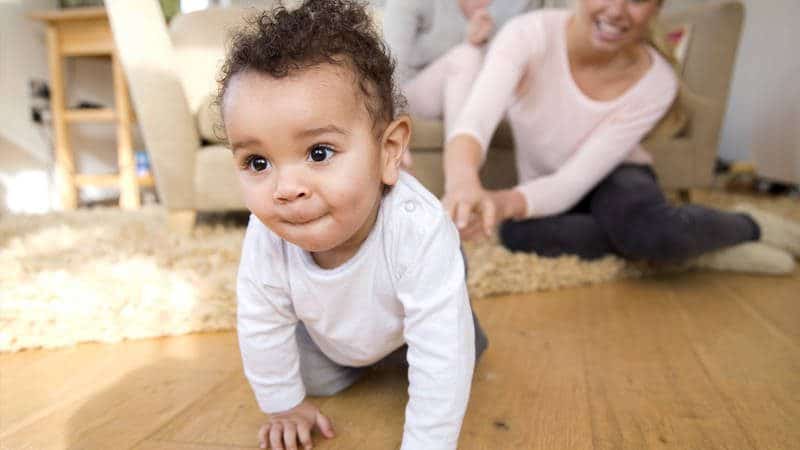The process of learning to crawl is actually pretty complex. Try these tips to support babies as they explore movement through crawling.
Many parents feel eager for their baby to start moving. If you’re in a hurry for this skill, just remember all babies develop at their own pace (and it will mean more babyproofing, so why rush?) By 9 months of age, most babies have started to crawl or move around in some way. They may roll to reach a new location or creep, cruise, and/or pull to standing.
The process of learning to crawl is a complex one. Your baby needs to coordinate many areas of their body. It can take a while to get moving, and that’s okay.
- Creep: Babies push themselves along on their bellies.
- Crawl: Babies move on their hands and knees
- Cruise: Babies pull to standing and move from spot to spot while holding onto furniture
Babies on the Move: Learning to Crawl
Pushing a baby to develop a skill they aren’t ready for can backfire and slow down the learning process.
When a baby shows signs of being ready, such as more movement during tummy time, here are some strategies to try.
How to help baby learn to crawl:
- Give baby lots of time on firm surfaces, like the floor. If you’re worried about cleanliness, put down a blanket. Beds are often too soft to help baby develop the muscles and balance they need for mobility. Plus, you have to watch them closely so they don’t fall off.
- Let your baby go barefoot. Baby shoes look cute, but babies need all the muscles in their feet and toes to grip the floor.
- Give your baby plenty of tummy time. On their belly, your baby develops muscle strength in their shoulders, arms, back, and trunk (torso) to help them learn to crawl.
- Encourage baby to reach for and move toward the toys and objects they are interested in. Lay interesting items a short distance from your baby. See if they are able to move themselves toward these objects.
- Make sure baby has safe space to explore where they can roll, crawl, and pull-up. But keep your eye on them! Your baby may surprise you by moving quickly and end up in a sticky situation. Now is the time to begin child-proofing your home. Take a walk through (or better yet, a crawl-through) your home and see what potential hazards may be at your baby’s level.
- Place the palms of your hands behind your baby’s feet when they are on all fours. This helps them feel stable. It also gives them something to “push off” from while they are learning to crawl.
Things to Avoid to Help a Baby Learn to Crawl
- Baby walkers. Not only are they potentially dangerous, they limit practice time on the floor learning to crawl. Walkers can also hamper muscle development.
- Spending lots of time in baby seats and baby carriers. Babies learn how to crawl, and later pull up to stand and then walk, when they have plenty of time each day to play, move, and explore.
- Pushing your child to learn to crawl. Pressing a child to develop a skill he isn’t ready for can actually slow the learning process.
Learning to Crawl Doesn't Always Look the Same
Your baby will find their own way of crawling.
When babies start crawling, they may even go backward at first and get upset to find themselves going in the wrong direction. They may start crawling on their hands and knees or “army crawl” on their stomachs. Some babies “crab crawl” sideways. Others may scoot on their bottoms. There’s no wrong way to crawl. In fact, there are several different types of crawling.
Crawling is not thought of as a milestone because some babies skip it.
None of these different ways of learning to move around is any better than the other. If you have questions about your baby’s physical skills, ask your child’s health care provider for a developmental screen—but chances are, everything is perfectly fine.
If your baby is slow to become mobile, keep in mind that some babies start crawling at a, well, crawl. Before you know it, you’ll be chasing them around, just trying to keep up!
Read More



